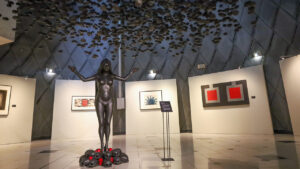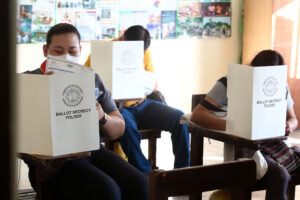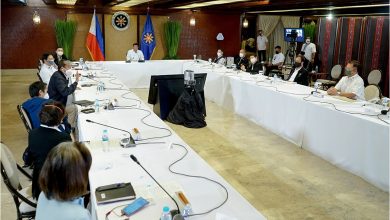On revising the 1987 Constitution

Cha-cha is in the air again. I was asked in a recent congressional hearing: A.) Do I favor revising the 1987 constitution? Answer: I do. B.) What modality? Answer: A constitutional convention. Recent actuations of Congress convince me that a Con Ass (constituent assembly) will pass purely self-serving provisions. C.) When? Maybe later when the economy has stabilized: the present crisis dictates that we grow the economy first. A Cha-cha, as charter change is referred to colloquially, now will postpone needed investment and growth.
I am not a lawyer nor constitutional expert. But I am a citizen who the constitution is intended to edify and inspire. As a citizen, I believe that a constitution should satisfy a modicum of aesthetics. Many talking heads would scoff at the mention of aesthetics in such a serious discourse. But even in the hard sciences, aesthetics is ignored with risk. Paul Dirac, one of the revered fathers of modern Physics, preached that a theory that lacks beauty should not be taken seriously. Aesthetics in constitutional writing, usually touching on the length or size, has been long debated. One side says that constitution should be lengthy to leave little doubt about what is meant. The other side disagrees; it says:
“Long constitutions, in contrast, are seen as exercises in obscure legalese: confusing that which should be clear; obfuscating that which should be common knowledge. In other words, they are presented as just another con by which ‘they’ keep ‘us’ far from power.” (Bulmer Elliot, Jan. 24, 2021, The National)
I have personally embraced the latter side of this debate. I believe that a constitution should be short and pithy, written in noble and heroic prose if not poetry (if need be, recruit UP Emeritus Professor Jose “Butch” Dalisay for the purpose) to inspire the nation to thoughtful patriotism.
Like Sunday sermons, constitutions if too long erode the listeners’ attention and transform commitment into indifference or worse. Mark Twain relates of a prelate who was preaching for donations to a worthy cause: aiding those who are in dire need but too proud to ask for it. So, aroused at the start, Twain was ready to part with $400 for the cause; but his frenzy cooled off with each seemingly endless additional stanza of the prelate’s peroration until, when the collection plate finally came, Twain recalls he filched a penny from rather than contribute to the plate. Length has turned commitment into crime.
Similarly why a constitution should be short, containing just the vision and the basic principles that must guide the pursuit of that vision. These are the enduring values.
The reason our constitution is unnecessarily long is because it also includes policy instruments. Policy prescriptions are chosen to reflect the technological and physico-social constraints of the moment. These constraints are always changing and time-bound. They are transient issues. Policy instruments must therefore be left to the legislature of the moment to formulate to reflect the physico-social and technological constraints of the moment. The comingling of principles and policy prescriptions leads to frequent changes in the Constitution, exemplified by the 1935 Constitution (three times in 12 years).
The 1987 Philippine constitution fails the simple aesthetics of brevity on the separation of principles and instruments. The section “State Policies” contains 27 sections, all of which constrain future governments in certain directions. What it tells us citizens is that the framers of the 1987 Constitution harbored a deep distrust for future governments to act with prudence so their hands should be tied. But this also limits their capacity to respond to changing socio-physical and technological environments. Resilience be damned!
Two policy prescriptions in the 1987 constitution especially bug me. Let me hasten to Article XII on “National Economy and Patrimony.” Specifically, Section 11 which restricts foreign ownership to 40% of capital, thus to a minority interest. This is a policy choice that the framers thought may advance national welfare. This is heavily contested. That native born actors are better stewards of the national patrimony is an article of faith, not a demonstrated fact. (The new Philippine Competition Act though has expanded the compass of activities exempt from this 40% ownership restriction).
The Terminal 3-Philippine International Air Terminals Co., Inc. (PIATCO) scandal shows a good deal of the effects of the foreign ownership restriction. The construction and operation of the Terminal 3 of the Ninoy Aquino International Airport or NAIA attracted foreign interests, among them Fraport. But the ownership restriction on foreign ownership means that the foreign interest cannot own and run the facility. It needed a local majority partner (some say a dummy). It found one, but the partner was embroiled in corruption cases leading to lawsuits that caused the completed Terminal 3 to be mothballed for a decade since delivery in 2002. In 2016, the Philippine Supreme Court, following an arbitral ruling, ordered the Philippine government to indemnify PIATCO P25 billion. Had the ownership restriction not been there, Terminal 3 would have been run and earning since 2002 and the P25 billion indemnity would have been avoided. Twenty-five billion pesos was the cost of the foreign ownership restriction in just this one case.
That Fraport itself did not have a clean record in its past dealings is not relevant: other more upfront foreign investors would have bid for the project if the ownership restriction did not exist. That there were local interests and funding for the project is also irrelevant. The fact is that the local consortium disbanded midstream which made foreign capital a requirement. If it showed anything, the ownership restriction also spawned the “dummy partner” industry which engendered even more corruption.
Under Section 4, Article XIII “Social Justice and Human Rights,” subsection “Agrarian and Natural Resources Reform,” it is stated: “To this end, the state shall encourage and undertake the just distribution of agricultural land.” Land reform was one policy instrument among possibly many others to further farmer welfare at that point in time. In lieu of land distribution, Professor Shinohara, then visiting the UP School of Economics, recommended higher farm land taxes to be earmarked to tenants. This would have left the farm production structure intact and would cost infinitely less. But irrational exuberance and zealotry won the day. The Comprehensive Agrarian Reform Program, more commonly known as CARP, defined farmer welfare as land ownership and equity completely trumped land efficiency. But ownership of a hectare of land does not push a farmer out of poverty; it does not pay for the education of farmers’ children; only farmer income does. The framers of the constitution could not conceive of the considerable distance between a piece of land and income. And the result is farmer poverty.
Farmer welfare was wrongly identified by CARP with some certificate of ownership. Thirty years after the 1987 constitution, the only meaningful marker for farm household welfare is farm income, which draws from the efficient use of the land not from ownership. Consolidation of farms rather than fragmentation of farms has now become exceedingly more important for farm efficiency. But as useful as farm consolidation is as a policy instrument today, it has no place among the basic principles in the rewritten constitution.
I humbly suggest that the rewritten Philippine constitution drop Section 10 and 11 of Article XII and Section 4 of Article XII and all other policy instruments masquerading as basic values. Will the lifting of these provisions create a tsunami of foreign and domestic investments? With other hurdles like high power cost unresolved, perhaps an improvement at the edges but not a tsunami!
Raul V. Fabella is a retired professor of the UP School of Economics, a member of the National Academy of Science and Technology and an honorary professor of the Asian Institute of Management. He gets his dopamine fix from bicycling and tending flowers with wife Teena.




